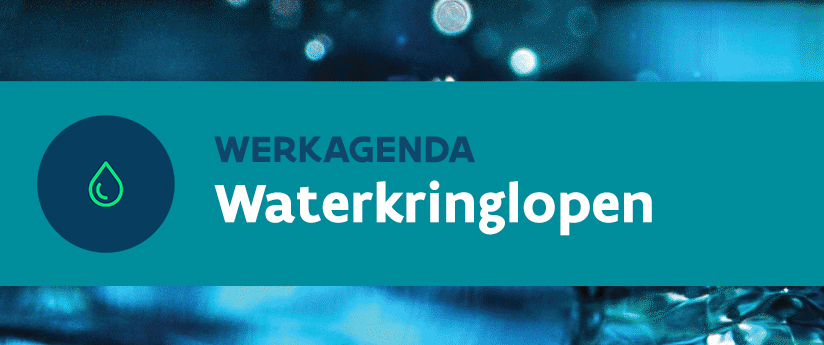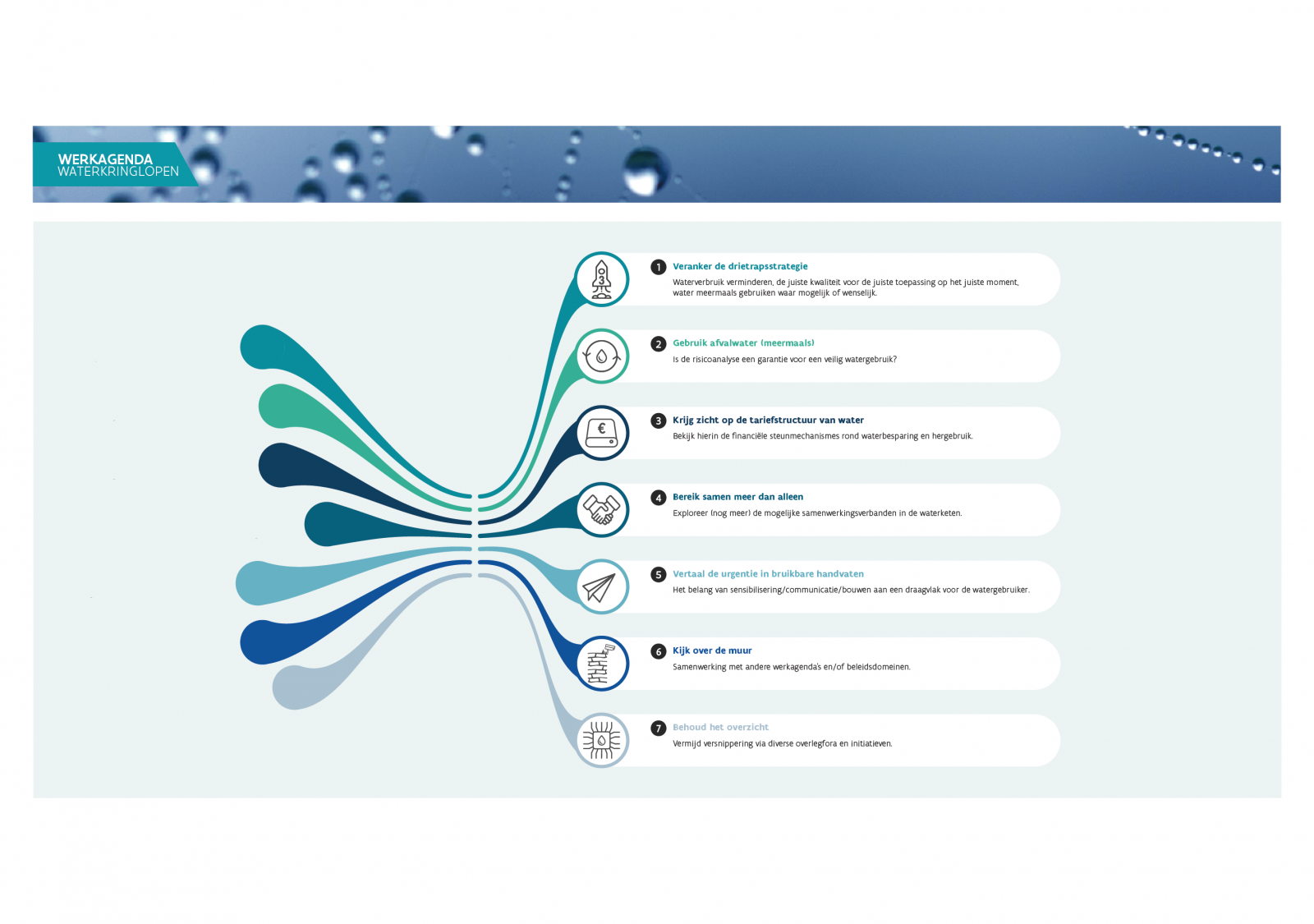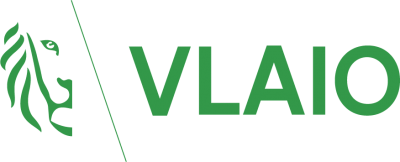Topics
We organise our actions in six thematic & strategic agendas:
Strategic Agendas:
Bio-economy
Circular Construction
Chemicals/Plastics
Manufacturing Industry
Food Chain
Water Cycles
Seven leverages provide additional support:
Leverage effects:
Lever Policy Instruments
Lever Circular Procurement
Lever Communication
Lever Innovation & Entrepreneurship
Lever Financing
Lever Jobs & Skills
Lever Research
What, why and how?
Why are we pursuing a circular economy?
Future visions 2050
How do we see our circular future?
About our management
Who steers what at Flanders Circular?

Our Approach / Strategic Agendas
Water cycles

Work paths and actions
To realise our goals and ambitions, we define seven work paths. These work paths align with current priorities to strengthen and/or accelerate circular water. Engagements and actions in our rolling strategic agenda can then be linked to one or more work paths.
- Anchor the three-step strategy: reduce water consumption, right quality for right application, use water multiple times where possible.
- Wastewater (reuse): does risk analysis guarantee safe water use in water exchanges?
- Get insight into the pricing of water and in this, look at the financial support mechanisms around water saving and reuse.
- Achieve more together than alone: leverage partnerships in the water chain more.
- Translate urgency into actionable tools for water users: the importance of sensitisation/communication/building a support base.
- Looking over the wall: cooperation with other strategic agendas and/or policy areas.
- Who keeps the overview: avoid fragmentation through various consultative forums and initiatives.
Why this working path?
Circular water use is part of a broader strategy to use water sustainably.
For this, it is important to go through a number of steps, preferably in the order of the three-step strategy:
- Avoiding or reducing water consumption, using water more efficiently.
- Selecting the optimal water source according to the intended application and appropriate water quality, at the right time, with consideration for safety and the environment
- Using the water several times where possible
In applying the three-step strategy, it is important to consider regional variability and environmental context, available water resources and application. But potentially undesirable side effects of water reuse should also be given due consideration, e.g. the environmental impact of concentrated residual discharges or high energy consumption
What happens in this working path?
In this work path, we explore how to embed the three-step strategy, and preferably as early as possible in project processes. This means before the start of the official permit procedure e.g. during the feasibility study. After the licensing phase, fundamental adjustment is not so easy.
Why this working path?
We need to be smarter and more efficient with water and thus also with wastewater. Wastewater is currently still (too) much discharged into surface water or sewers and (too) little reused. But using wastewater (more than once) also entails a certain risk for people and the environment. The extent of this risk can be defined as the impact of the risk multiplied by the probability of the risk actually occurring.
What happens in this working path?
The actions within this work path aim to answer key questions that are barriers to wastewater reuse.
What are the risks for humans (e.g. transmission of infections) and the environment (e.g. impact water quality surface water, soil, groundwater)? How can we minimise them? How much risk do we consider acceptable? As a user or as a provider? How much security do we want in the system both in terms of liability of providers and security of use of customers? What is the threshold for certain investments from the risk approach? What data are necessary to make a judgement on this?
The discharge of concentrated residual streams also has a significant environmental impact and is therefore often a bottleneck for the licensing of water reuse projects. To reduce the risk to the environment, there is much potential in addressing the residual flow issue. Research into this could be included jointly with the Research and Development platform of the Coordinating Committee on Integrated Water Policy (CIW).
Why this working path?
The cost of a resource (type of water source) helps influence which water source is used. Tinkering with the price of a particular water source can impact the use of other water sources or the financial viability of water reuse.
What happens in this working path?
In this work path, we want to look at how to facilitate the financial feasibility of water reuse. An important starting point is the definition of cost price. What costs do we include, what are fixed/variable costs? What share goes to charges or fees? What premiums, subsidies are in return?
The demand to charge for all water sources is growing (e.g. with the discussion on the tariff change for surface water capture). As concerns here, we can cite the need to avoid sending everyone to the same water source, avoid unwanted shifts and monitor the 'level playing field'.
Why this working path?
To accelerate circular water use, thinking about optimal water reuse within and between sectors in the water chain is necessary. Cooperation between actors can lead to fruitful synergies, giving rise to additional opportunities or solutions. The 2021 Voka survey, for example, confirms that there is a lot of potential in exchanging wastewater between companies.
Opportunities for collaboration often go beyond water flows and can be extended to other circular challenges. How can we detect nodes in function of certain flows (energy, water, mobility, raw materials)? Here, we recognise the role and necessary cooperation with experts e.g. in water treatment and management: 'Water as a service' may not yet be sufficiently explored as a solution to difficult water challenges.
What happens in this working path?
In this work path, we look at how to strengthen the exchange of water flows between various actors or other forms of water cooperation. We do this by removing bottlenecks and increasing the economic benefit. For example, consider a company that wants to offer its wastewater to a nearby company or two companies working together to tap an alternative water source or find a discharge solution for their wastewater. Here, we are also looking at opportunities in business parks where proximity can be a powerful lever.
Why this working path?
Belgium is one of the European leaders when it comes to water stress. Compared to most European countries, we have much less water available per inhabitant. Climate change will only increase the urgency of dealing with water sustainably. Yet not everyone is yet aware of this problem.
What happens in this working path?
With this working path, we want to focus on initiatives that further build support for dealing with water sustainably. How can we efficiently raise awareness, communicate or inspire and learn?
In doing so, we pay attention to the needs and characteristics of the various types of water users, just think of the differences between households versus businesses. We work in a complementary way to existing communication initiatives.
Why this working path?
To avoid island thinking as much as possible, we want to build bridges to other policy domains. This concerns both the working agendas under Flanders Circular but also other platforms or specific policy and action plans. We want to use opportunities to write a common transversal story where possible.
What happens in this working path?
We are looking for how to better align processes e.g. in circular building, energy, bio-economy. However, we need to guard the scope of this work path because it is rapidly going much wider than relevant to circular water use.
Why this working path?
This working path captures the feeling that there are a lot of initiatives and trajectories ongoing around circular water but that the overall overview disappears or becomes blurred as a result.
What happens in this working path?
The actions within this working path aim to answer key questions that are barriers to wastewater reuse.
We look at how initiatives around circular water can be gathered within the workings of the Coordinating Committee on Integrated Water Policy (CIW). Three main pillars here are:
- Sharing knowledge: Being aware of what partners and key stakeholders are doing and what they are working on. Exchange knowledge and cross-pollination on experiences, barriers and levers of projects, research and policy processes. Explore how/through which channels this can best be done.
- Taking action together: A mutually reinforcing flow that enables realisation and participating together. There is a realisation-oriented agenda with clear goals and (intermediate) deadlines. The flow produces more owners for the end result.
- Making commitments together: From the mutually reinforcing flow, agreements are made to share people and resources to achieve better and more widely supported results together more cost-effectively.
The participants and actors involved may vary depending on the topic applied.


















